What Is FACE?
The Future Airborne Capability Environment (FACE™) is a collaboration between government and industry that created a software standard to provide an open systems approach for military aviation solutions, delivering software-defined capabilities to the end user faster and more affordably. The FACE business strategy establishes a balanced, competitive environment for both large and small software suppliers.
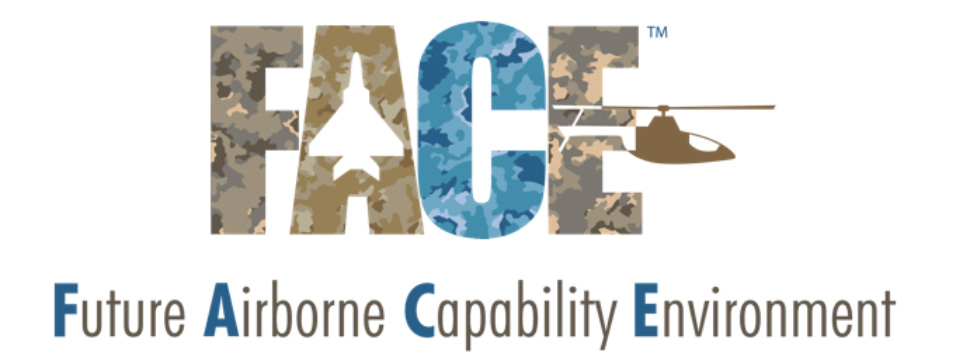
FACE defines a standards-based reference architecture for emulating and improving on commercial successes for U.S. Department of Defense (DoD) military aircraft. It is governed by the Open Group FACE Consortium, of which Wind River® is a founding member. The FACE Reference Architecture increases interoperability and portability across hardware platforms and aids component reuse by defining design principles such as standardized interfaces across modular software. It signals an end to the practice of creating single-use software for each aircraft model, instead supporting a common operating environment where software developers can, theoretically, create and deploy applications for use across any military aviation system.
The FACE Technical Standard
A critical function of the FACE Consortium is to enable the software ecosystem that supports FACE architecture. That enablement includes tools and processes to verify and certify conformance with the FACE Technical Standard through designated certification bodies. Once a software component receives its certification of FACE Conformance, it can be included in the FACE Registry. It is then referred to as a “unit of conformance” (UoC). Architects can choose and use several UoCs with a given avionics solution.
Meeting the FACE Technical Standard requires going through the FACE Conformance process. FACE Conformance confirms the proper use of the defined FACE Interfaces and the exact following of the FACE Reference Architecture, helping suppliers meet the needs of a new era of rapid integration and deployment of global avionics software.
One key method to achieve FACE Conformance under the Safety, Safety-Extended, or Security profiles is to ensure that the avionics solution specifies a partitioned operating environment to prevent interference between workloads.
“The FACE Consortium efforts indicate the willingness and self-motivation to pursue our evolving vision in the area of open architecture, model-based engineering, and efficient system integration. The FACE Standard represents a potential shift in the paradigm towards the vision we are pushing, and potentially a new era of government and industry collaboration.”
—Dan Bailey, Program Director, Joint Multi-Role (JMR), U.S. Army
This requirement is particularly relevant for mixed-criticality systems, as well as for isolation that minimizes disruption when replacing modular software components. Hardware-based isolation between processing cores must typically be augmented by software measures at the operating system and virtualization levels, which are provided by FACE-conformant products from Wind River.
FACE Architecture
The concept of the FACE Standard is to provide a reference architecture based on segments, which can be composed to meet the final system requirements. Variations in the content of the segments, including application code, allow the system architect flexibility in designing and building the end system. FACE provides the logical interfaces between these segments to allow portability and reuse.
The five segments are:
- Operating System Segment (OSS): Foundational services are provided by an operating system. The remaining four segments depend on the OSS.
- Portable Components Segment (PCS): This offers capability or business logic.
- Transport Services Segment (TSS): This segment provides communication services.
- Platform-Specific Services Segment (PSSS): This provides platform services, such as data services, logging, health management, and graphics (with an interface to the GPU).
- I/O Services Segment (IOSS): This segment normalizes the interface to I/O devices.
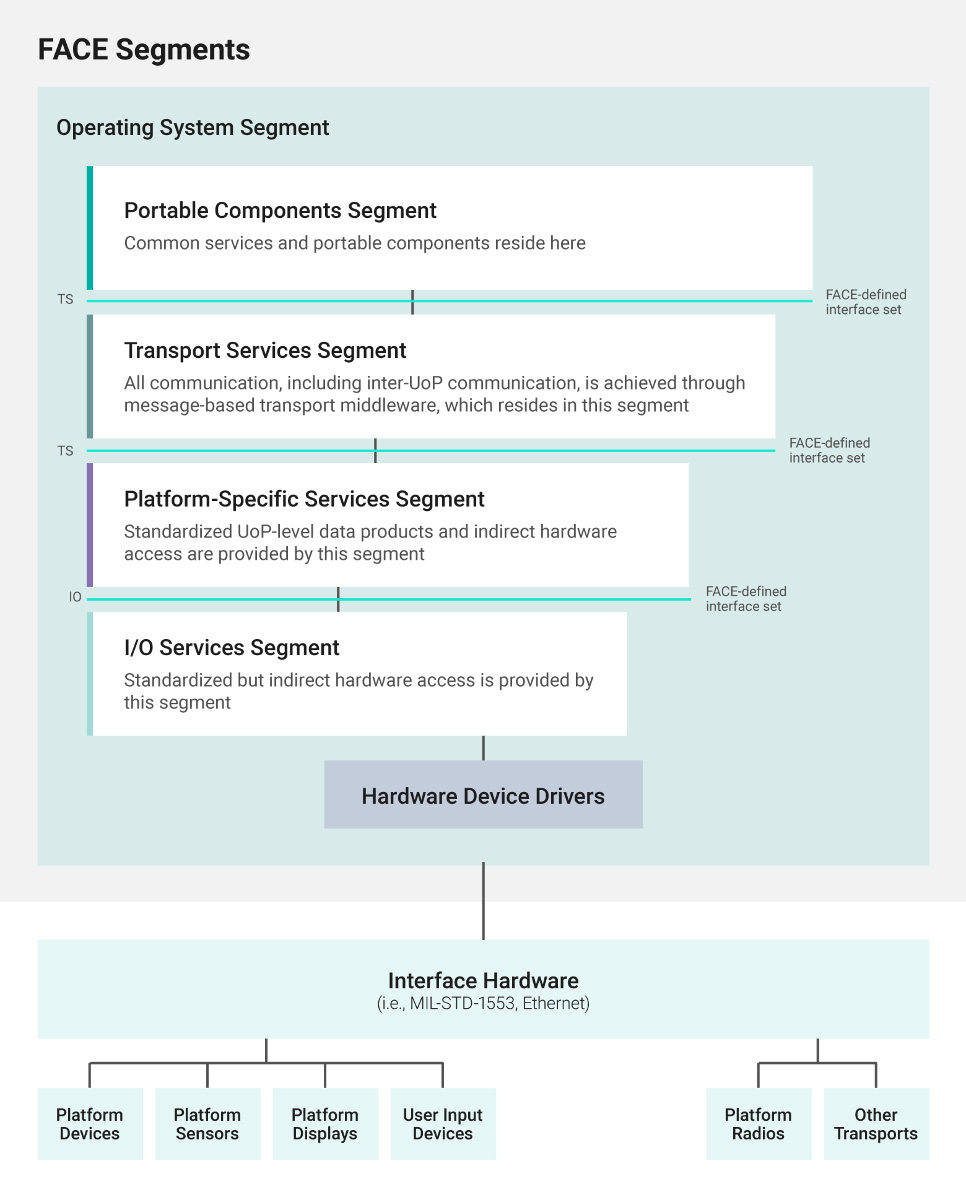
FACE architectural segments are related by FACE-defined interfaces.
OSS Profiles
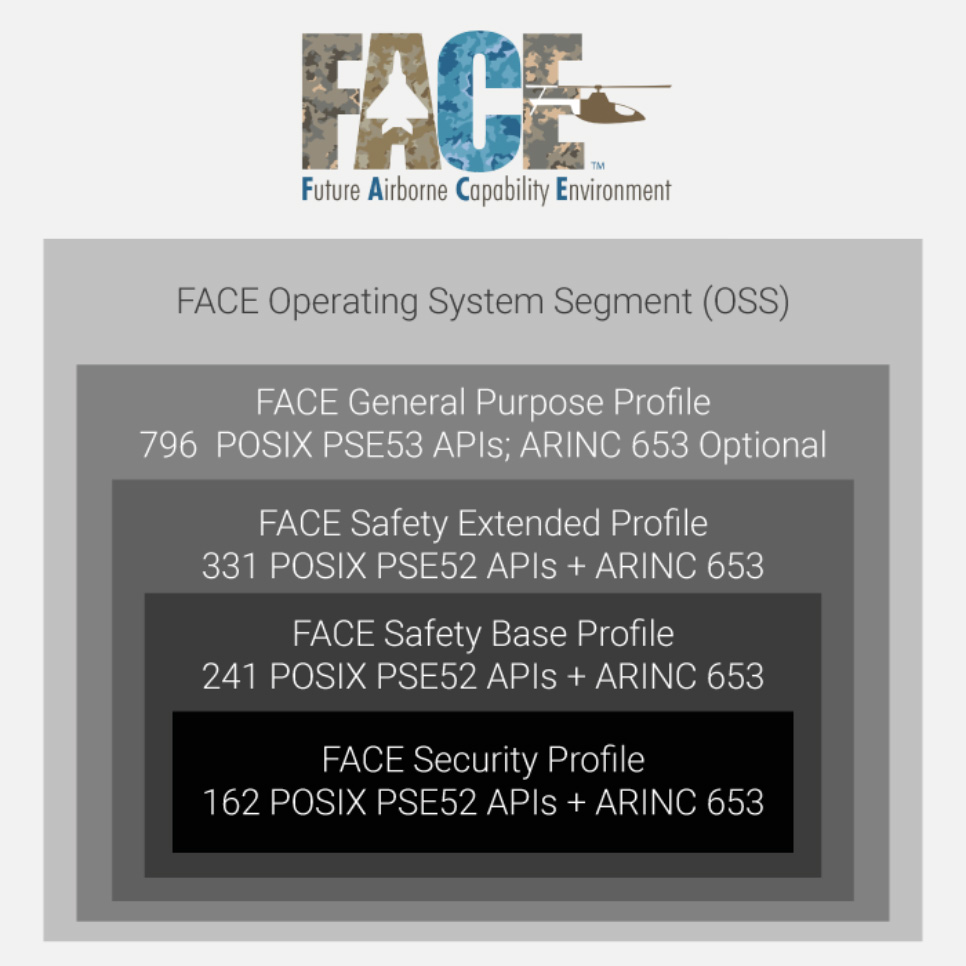
FACE Operating Systems Profiles
Key to constructing the system are the interfaces between these segments, defined by the FACE Technical Standard. For the OSS, the focus is on the supported application programming interfaces (APIs) and the way they fit into different profiles. These profiles are Security, Safety, and General Purpose:
- Security: This profile is the most restricted and has a minimal set of APIs for high-assurance applications.
- Safety: This profile is a superset of the Security profile, with more APIs. It is intended for applications that require safety certification and has two further sub-profiles: Base and Extended.
- General Purpose: This profile has the most APIs and supports applications that do not necessarily need real-time or deterministic response.
To maintain commonality across different FACE component suppliers, solutions are tested against these API sets and awarded Conformance Certification.
Partitioning
The FACE Technical Standard also calls for support for partitioning, depending on the profile in question. This technique is used in many types of computing systems. Partitioning supports modularity, including support for the concept of integrated modular avionics (IMA).
The isolation properties provided by the partitioning of distinct applications are essential to achieve the promise of the FACE standard, for two reasons. First, interoperability and smooth integration require isolation so that there are no surprises due to unanticipated interactions when new independent functions are added to the system. Second, certification of mixed-criticality systems is founded on the isolation of partitions.
The General Purpose profile uses space partitioning, while the Safety and Security profiles require both time and space partitioning. These requirements stem from the ARINC 653 standard for safety profiles in safety-critical avionics.
Advances in Multi-core Processors
With the advent of powerful multi-core processors, the drive to use partitioning to separate critical applications is accelerating. With single core processors, the ability to host applications at different criticalities was achieved using time and space partitioning in an IMA architecture developed to overcome issues of space, weight, and power (SWaP) in commercial aircraft. This was needed to meet the increasing requirements for more and more capability within the airframes of the era, as exemplified by the Airbus A380 and Boeing 787.
However, what this technique did was to essentially “share” the CPU resource across multiple applications. While it achieved the goals of an IMA architecture, it also impacted the performance allocated to applications. With the latest multi-core applications, however, performance impact can be mitigated by allocation across multiple cores. These systems are breaking new ground in the safety certification of complex systems.
No Performance Requirements
The FACE standard intentionally avoids dictating performance or quality of applications, focusing instead on a standard interface with defined behavior. This open standards approach levels the playing field. All vendors must use the same API and must then compete on such characteristics as performance, quality, tools support, and depth of airworthiness evidence. For example, multiple vendors might provide a FACE OSS that has been certified conformant to the FACE Technical Standard, with each providing the same expected API to interface with other elements of the system. However, the timing characteristics — such as response time or partition window jitter — may vary widely between systems produced by different vendors. Some vendors might provide a package of flight certification artifacts while others do not, and the strength of the tool’s ecosystem related to the OSS may vary significantly between vendors.
The FACE Vision
The vision of the FACE Consortium, a voluntary consensus standards body comprising more than 90 government and industry organizations, is to fundamentally transform the process of airborne software development, procurement, deployment, and sustainment by eliminating platform-specific, tightly coupled designs with unique and closed interfaces that inhibit cross-platform reuse and interoperability between systems. Consortium members worked together to solve the myriad technical and business challenges and transformed these processes and systems, with a focus on the wide adoption by multiple services and agencies of open architectures and open component interfaces.
FACE built a set of open standards for portable, capability-based applications for Department of Defense (DoD) avionics systems with the following characteristics:
- An open architecture and a common data model
- An integrated modular avionics (IMA) approach proven by the commercial aerospace industry
- More than 100 existing aerospace and defense standards in use
- Methodological support for components that are portable, modular, partitioned, scalable, extendable, safe, and secure
- A foundation of testing and conformance to reduce integration risk and maximize interoperability between applications
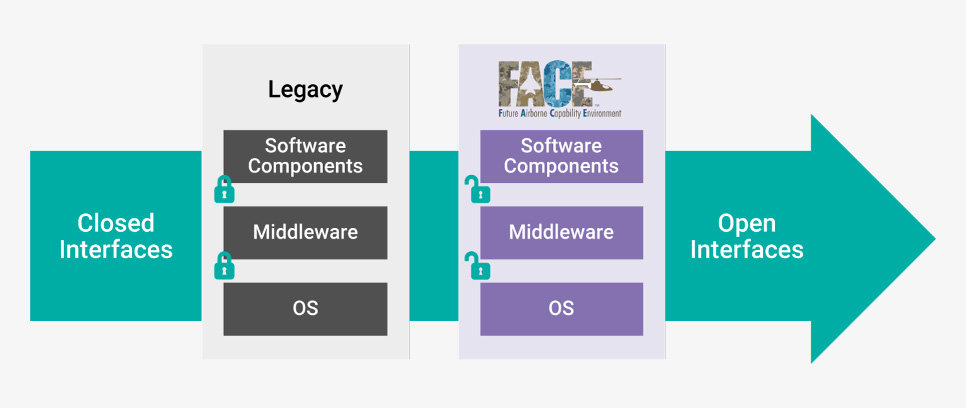
The FACE vision requires the removal of closed, proprietary components and the wide adoption of open architectures and open component interfaces.
Who Should Care About the FACE Approach?
Any military avionics contractor to the DoD should already be familiar with FACE technical and business standards. The U.S. is the largest market for avionics, and FACE requirements have been specified in more than 50 public government procurements with FACE requirements (see www.opengroup.org/face/procurements). There are also multiple nonpublic procurements with FACE requirements within the U.S. Air Force, U.S. Army, U.S. Navy/NAVAIR, DARPA, and U.S. SOCOM. The standard is now well entrenched in U.S. military procurement operations. Some foreign militaries and commercial aerospace airborn platforms are also standardizing on FACE.
How Can Wind River Help?
Wind River fully supports the global standardization efforts of more than 30 military avionics suppliers to create open platforms for rapid integration of a wide source of legacy and new applications on critical avionics systems. FACE is managed by the Open Group. As a founding member of the FACE Consortium, Wind River delivers safe and secure platforms that will support the FACE Reference Architecture’s General Purpose, Safety, and Security operating system profiles.
Wind River affirmed its leadership position in the marketplace of trusted, certified FACE-conformant products by having the first commercial off-the-shelf (COTS) OS product to achieve this significant FACE certification milestone. This certification allowed VxWorks® 653 to usher in a new era of open architecture avionics for the benefit of the global avionics community.
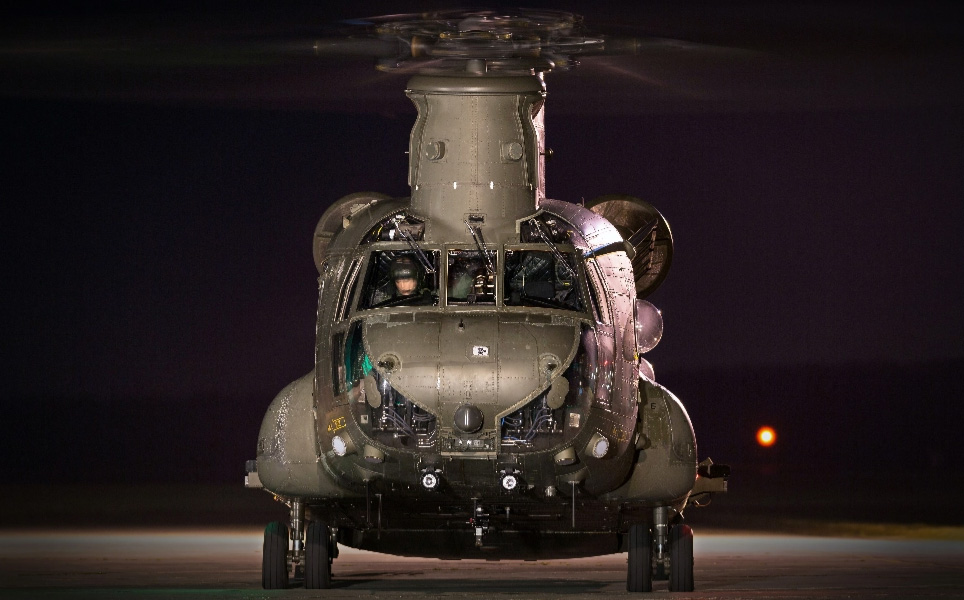
VxWorks 653 was the first COTS operating system product to achieve FACE conformance.
FACE General Purpose Profile, Edition 3.1
With full compliance to POSIX® 1003.1-2008, Wind River Linux fully complies with the FACE General Purpose profile that enables support for a wide range of applications on a standards-based foundation.
» Explore Wind River LinuxFACE Safety Profile, Edition 2.0
For applications with strict safety and/or ARINC 653 time and space partitioning requirements, Wind River VxWorks 653 Platform is the choice for meeting the FACE Safety profile, Edition 2.0. With more than 220 customers using VxWorks 653 on over 360 programs on more than 100 aircraft, VxWorks 653 is the market-leading ARINC 653 platform solution and will enable a wide range of commercial and military applications to be deployed on FACE platforms.
» Explore VxWorks 653FACE Technical Standard, Edition 3.1
Wind River VxWorks 653 Platform has achieved conformance to the FACE Technical Standard, Edition 3.1. The certification establishes VxWorks 653 as an OSS that supports the FACE Safety Base sub profile.
» Explore VxWorks 653FACE Technical Standard, Edition 3.2
Wind River Helix™ Virtualization Platform has achieved conformance to the latest FACE Technical Standard, Edition 3.2. The certification establishes Helix Platform as an OSS that supports the FACE Safety Base profile.
» Explore Wind River Helix Virtualization Platform